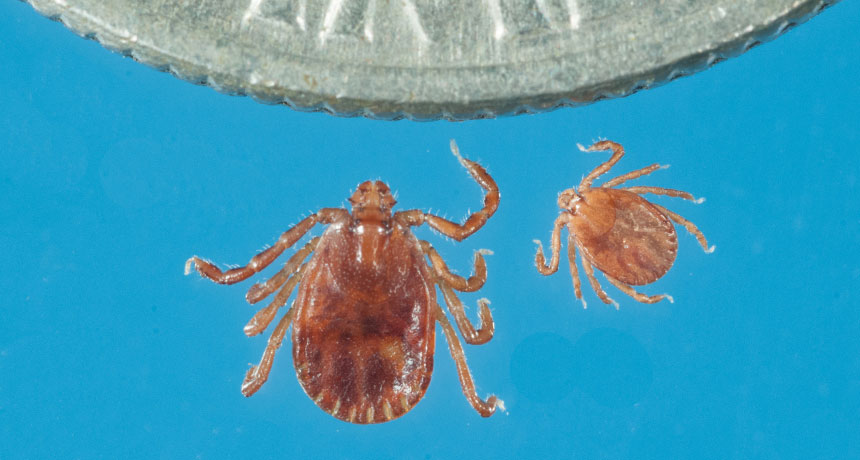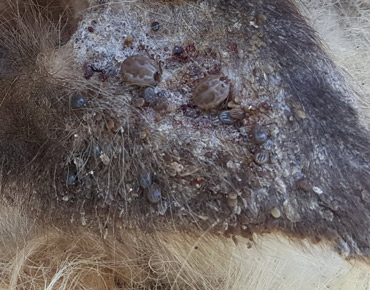An Asian, self-cloning tick threatens U.S. livestock
In its native range, this arachnid spreads dangerous human diseases

Scientists have discovered the longhorned tick in four U.S. states. This species can reproduce by cloning. Here, an adult and a young tick, or nymph, are shown next to a dime.
J. Occi/Rutgers Center for Vector Biology
Tadhgh Rainey has seen plenty of bloodsuckers. He’s an entomologist — a scientist who studies insects — at the Hunterdon County Health Services in Flemington, N.J. He knows all about mosquitoes and ticks. But he had never seen anything like the September 2017 infestation on a pet sheep.
As he and a colleague entered the sheep’s enclosure, “We almost immediately got covered in ticks,” he says. “I couldn’t believe this sheep was alive.” It was covered in hundreds — maybe thousands — of the ticks. (By the way, ticks are arachnids, not insects.)
Rainey couldn’t identify the species. So he sent samples to labs across the United States. One went to Andrea Egizi. She’s an entomologist at Rutgers School of Environmental and Biological Sciences in New Brunswick, N.J. When she analyzed its DNA, she was shocked to learn it was a native of East Asia.
This bush or longhorned tick has a long name too: Haemaphysalis longicornis (HEE-muh-fih-SAAL-is Lon-jih-KOR-nis). It can be found all over Japan, China and the Korean Peninsula. That unlucky New Jersey sheep was the first reported sighting of the tick in the continental United States, say Rainey and Egizi. They described their finding online February 19 in the Journal of Medical Entomology.
It’s rare to find a new immigrant tick species in the wild, scientists say. And this one seems to be spreading. It has so far also turned up in Virginia, West Virginia and Arkansas. People in Maryland are now on the lookout.
Here are five reasons why scientists are keeping an eye out for this sneaky invader.
1. This tick can clone itself.
After a female longhorned tick eats, she can lay up to 2,000 eggs. All have the exact same DNA as their mom. Two to three months later, the eggs hatch without any male fertilization. They grow into exact mini copies of their mom.
This rare way of reproducing without the genetic influence of a male is called parthenogenesis (Par-then-oh-JEN-eh-sis). Of the world’s more than 800 tick species, fewer than 20 appear able to reproduce this way.
Neeta Connally is a medical entomologist at West Connecticut State University in Danbury. She finds this process of reproducing is “pretty alarming.” Why? It creates a new generation of young far faster than with traditional mating. Longhorned ticks can reproduce in just six months. By contrast, common American ticks, such as the deer tick and lone star tick, need two years.
Researchers worry that this rapid cloning could lead to heavier tick infestations in short periods of time. The female longhorned tick doesn’t need to worry about finding a mate. She can focus on feeding, traveling and making more babies.
2. It’s not a picky eater.
Some ticks, such as the rabbit tick or the moose tick, specialize in just one type of host. They won’t feed on other animals. The longhorned tick is different. It rarely meets a blood source that doesn’t look appetizing. It will chow down on any bird or mammal it can get its hooks into — including humans.
3. It can carry human diseases.
No human bites have been reported in the United States thus far. But in its home range, this tick has proven a major public health threat. In China, Japan and Korea, for instance, it can carry any of several viruses and bacteria that infect people. Recently, this tick has been linked to a disease known as SFTS. That’s short for severe fever with thrombocytopenia (Throm-boh-sy-toh-PEE-nee-uh) syndrome. This disease causes dangerous bleeding. More than five in every 100 people who get this syndrome die from it.
SFTS has not shown up in the United States. But researchers worry that the immigrant tick might adapt to carry the diseases that native U.S. ticks do. Lyme disease is one. Lyme disease can give people flu-like symptoms. It also leaves them with a rash shaped like a bull’s-eye. And there are potentially fatal tick diseases that can affect the nerves and brains in people. These include ehrlichiosis (Air-lik-ee-OH-sis), anaplasmosis (An-uh-plas-MOH-sis), Rocky Mountain spotted fever and Powassan virus.

4. It’s a big threat to livestock.
At least for now, this tick poses the greatest risk to cows and sheep. The arachnid is great at transmitting the deadly cattle disease theileriosis (Thy-LEER-ee-OH-sis). Heavy infestations of the critters have also been known — like a vampire attack — to suck so much blood from a single animal that it dies.
“Keep an eye on your animals,” warns Denise Bonilla. She’s an entomologist at the U.S. Department of Agriculture Animal and Plant Inspection Service in Fort Collins, Colo. If farmers in affected areas are already giving their animals anti-tick medications, they should keep doing it, she says.
5. This tick is probably more widespread than we realize.
Researchers have no idea how and when the tick first got to the United States. They also don’t know how it’s been traveling within the country. It may, for instance, hitch rides on birds or horses.
Evidence shows the tick had already been in the United States before the New Jersey sheep infestation was discovered last September. After finding the ticks on that sheep, a Rutgers graduate student tested a tick collected in New Jersey in 2013. It also turned out to be a longhorned tick. Four years earlier, it had been misidentified as a native rabbit tick.
Considering the longhorned tick went undetected for years, Egizi is not surprised it has turned up in multiple states. “The more we look for it, the more we’ll find it,” she suspects.







